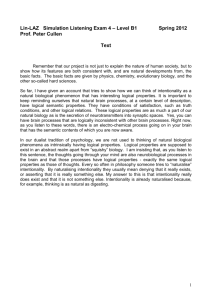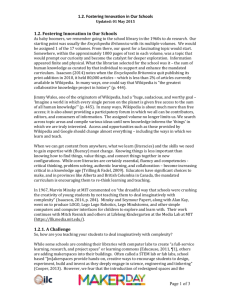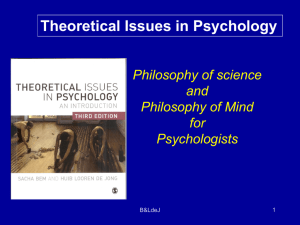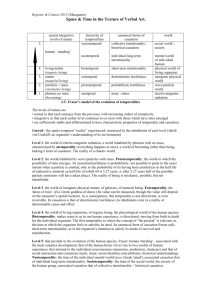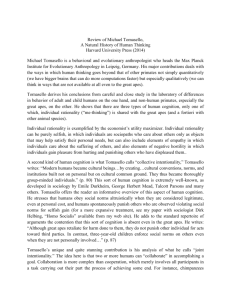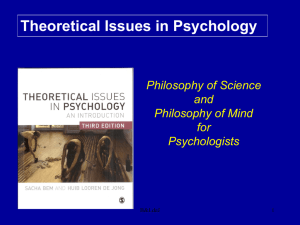Against.Derived.Intentionality
advertisement
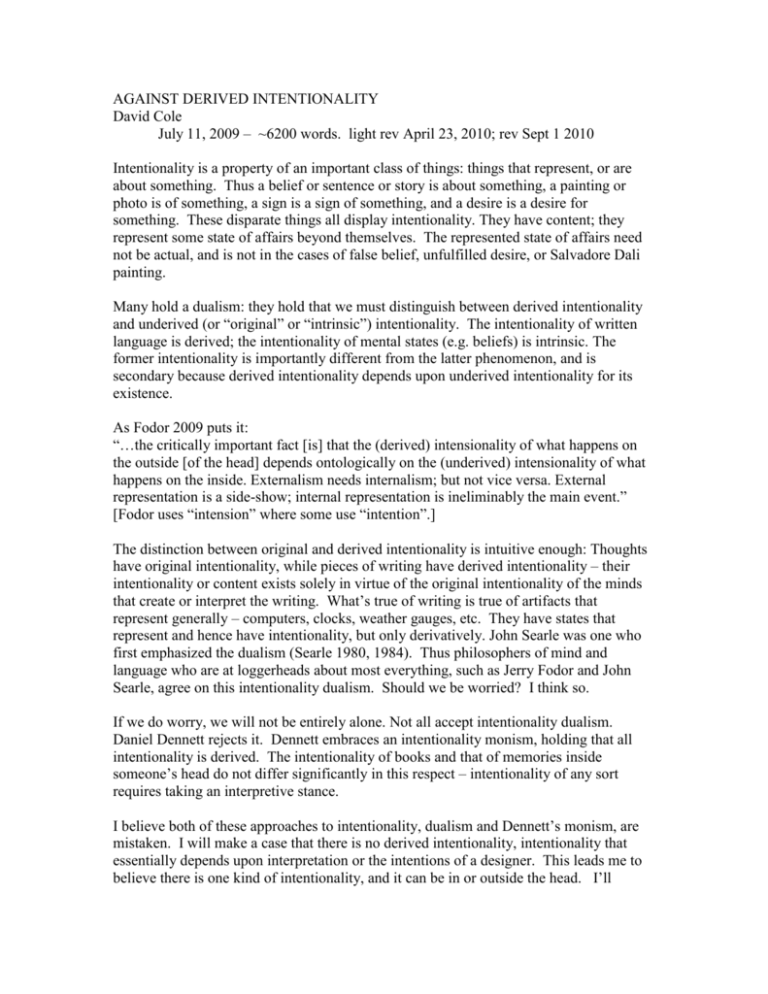
AGAINST DERIVED INTENTIONALITY David Cole July 11, 2009 – ~6200 words. light rev April 23, 2010; rev Sept 1 2010 Intentionality is a property of an important class of things: things that represent, or are about something. Thus a belief or sentence or story is about something, a painting or photo is of something, a sign is a sign of something, and a desire is a desire for something. These disparate things all display intentionality. They have content; they represent some state of affairs beyond themselves. The represented state of affairs need not be actual, and is not in the cases of false belief, unfulfilled desire, or Salvadore Dali painting. Many hold a dualism: they hold that we must distinguish between derived intentionality and underived (or “original” or “intrinsic”) intentionality. The intentionality of written language is derived; the intentionality of mental states (e.g. beliefs) is intrinsic. The former intentionality is importantly different from the latter phenomenon, and is secondary because derived intentionality depends upon underived intentionality for its existence. As Fodor 2009 puts it: “…the critically important fact [is] that the (derived) intensionality of what happens on the outside [of the head] depends ontologically on the (underived) intensionality of what happens on the inside. Externalism needs internalism; but not vice versa. External representation is a side-show; internal representation is ineliminably the main event.” [Fodor uses “intension” where some use “intention”.] The distinction between original and derived intentionality is intuitive enough: Thoughts have original intentionality, while pieces of writing have derived intentionality – their intentionality or content exists solely in virtue of the original intentionality of the minds that create or interpret the writing. What’s true of writing is true of artifacts that represent generally – computers, clocks, weather gauges, etc. They have states that represent and hence have intentionality, but only derivatively. John Searle was one who first emphasized the dualism (Searle 1980, 1984). Thus philosophers of mind and language who are at loggerheads about most everything, such as Jerry Fodor and John Searle, agree on this intentionality dualism. Should we be worried? I think so. If we do worry, we will not be entirely alone. Not all accept intentionality dualism. Daniel Dennett rejects it. Dennett embraces an intentionality monism, holding that all intentionality is derived. The intentionality of books and that of memories inside someone’s head do not differ significantly in this respect – intentionality of any sort requires taking an interpretive stance. I believe both of these approaches to intentionality, dualism and Dennett’s monism, are mistaken. I will make a case that there is no derived intentionality, intentionality that essentially depends upon interpretation or the intentions of a designer. This leads me to believe there is one kind of intentionality, and it can be in or outside the head. I’ll broach this heresy by way of critical discussion of the arguments for derived intentionality. In the course of that I’ll pick apart a few strands of the tangled web of epistemic and semantic issues that I believe have undermined thinking clearly about intentionality. And I’ll sketch a positive account of intentionality that accords it a full stature as a feature of the world not generally dependent upon acts of interpretation or states of consciousness. Intentionality Dualism Let us begin by looking more closely at the distinction between original and derived intentionality as set out by Searle. Searle tells us that mental states (e.g. propositional attitudes) display original intentionality, while language only has derived intentionality. As a paradigm example of original intentionality Searle 1984 (p. 77) gives us: Robert believes that Ronald Reagan is President. By contrast he offers the following as a clear example of derived intentionality: “Es regnet” means it’s raining. Of the quoted embedded German sentence he says: “That very sentence might have meant something else or nothing at all” (p. 78). To be sure, there is a difference between these examples. But on the face of it, the comparison displays a certain fault: there is a difference in the way the representations are picked out, or “individuated”. This is significant because the apparent difference between the intentionality in the two cases may be nothing more than an artifact of this difference in description. In the first case, the example of “original intentionality”, the belief is being described by its content or semantics – the belief that it is snowing is essentially (“intrinsically”?) the belief that it is snowing. Change anything about its meaning, what it is about, and it would be a different belief. But this leaves open the possibility that the physical state in the believer’s brain that records and is the physical basis of that belief might, depending on the rest of the brain and the causes of the brain state, “have meant something else or nothing at all”. Unlike Robert’s mental state, Searle characterizes the German sentence on the basis of its syntax. Those German words – the marks “es regnet” - might have meant something else or nothing at all. But if instead we use the same content-based individuated that Searle used for the belief, e.g. “Otto just said that it is raining” then we have also individuated language in terms of its semantics, parallel to the way Searle individuated the mental state. And Otto’s saying that it is raining cannot have meant something else, or else it would not be an instance of saying that it is raining. Note that the same distinction between two methods of individuation can be made even with instances of signs that are not directly produced by a human or something with consciousness. My microwave dings. The ding means something, but the ding might have meant something else, or nothing at all. But if we say that my microwave signaled that its cooking time is complete, then that signaling can’t mean something else. As in Searle’s examples, the difference is not in the phenomena, but in the method of individuation. Given their physical description, brain states might have had other, or no, content, as might the German words. Given their semantic descriptions, the examples of language and of mental states have their respective meaning properties essentially. Thus we have not at the outset been given clear evidence of a fundamental difference between the two cases, and hence motivation for intentionality dualism. Intentionality monism Dennett agrees with Fodor and Searle that language and other artifacts are paradigms of derived intentionality. But Dennett then goes on to argue that the requirement of interpretation that makes the intentionality of language derived applies also to inner states that Fodor and Searle have taken to have a different and more fundamental “intrinsic” form of intentionality. Regarding language Dennett agrees completely with the dualists. He says: “The point about the dependent status of artifactual representations is undeniable. Manifestly the pencil marks in themselves don’t mean a thing. This is particularly clear in the cases of ambiguous sentences. The philosopher W. V. O. Quine gives us the nice example: Our mothers bore us. What is this thing about? … You have to ask the person who created the sentence. Nothing about the marks in themselves could possibly determine the answer. They certainly don’t have intrinsic intentionality, whatever that might be. If they mean anything at all, it is because of the role they play in a system of representation that is anchored to the minds of the representers. (Dennett 1997 “Intentionality” in Kind of Minds p. 51) Where Dennett disagrees with intentionality dualists is in holding that all intentionality is of this derived type. And Dennett holds that the failure by intentionality dualists to appreciate this is a mistake of the utmost importance. He writes (Dennett and Haugeland 1987): “I have argued in … The Intentional Stance (Dennett, 1987) that clinging to the doctrine of original intentionality is the primary source of perplexity in contemporary AngloAmerican philosophy of mind…..” However I believe that in Dennett’s treatment of intentionality we can discern a problem that afflicts many discussions of intentionality and representation. Intentionality dualists, as well as those monists who see all intentionality as derived, show a lamentable tendency to conflate epistemology and semantics. Consider Dennett’s argument that it is obvious that the quoted sentence has derived intentionality. The argument turns on the point that to know what an ambiguous sentence means, you have to ask the author. You can’t tell from the marks themselves what they mean. These are epistemic complaints. How one can tell what something means, and what it means, are two importantly different things. One is semantic, the other epistemic. In fact, perhaps conflating these is in fact “the primary source of perplexity in contemporary philosophy of mind” - and philosophy of language and semantic theory. Consider natural signs. One can often figure out what something means by knowing what caused it. The world is such that some causes have unique effects – in the wild, smoke generally means fire. Other phenomena - spots on skin, say, to take a Grice example - can mean more than one thing. You can’t tell what the spots mean, what they are signs of, what disease is causing them in a particular case, without some more diagnostic efforts. But these epistemic problems have nothing to do with meaning, the significance of the symptoms and signs. Even when a sign (e.g. a tokening of “Fire!”) is directly caused by human agency (still the typical case with language, even as machines become increasingly talkative), the meaning arguably comes from the conventional link with a state of the world (the presence of a fire). With a tokening of something we have not encountered before – “Gavagai”, perchance – it is not our possibly mistaken interpretation that determines the meaning, but rather, if it is meaningful, the meaning is determined by a conventional connection with the world. “Nothing about the marks in themselves” determines the meaning, to be sure, but that is not because meaning is derived, but rather because meaning always depends on factors external to “the marks in themselves”. Let us return to consider Searle’s intentionality dualism for a moment. It seems likely that a conflation of epistemic and semantic issues may be at work in Searle’s later treatments of intentionality as well. Searle is struck by the fact that mental states such as one’s belief don’t require an interpretation step. They are experienced as having content; the conscious experience itself lets us know what the satisfaction conditions of our belief are. A written sentence may be ambiguous; a thought is not. Three points: first, yet again this is an epistemic point, not a semantic point. Knowing what a state of my brain means is distinct from what it means. The intentionality – a semantic property of aboutness – is not determined by how I come to know about it. Even when a state is experienced as wearing its significance on its sleeve, that epistemic fact about the state, while undoubtedly interesting, is distinct from its intentionality. Second, it is not clear, as Dennett notes, that this state of consciousness is not the result of a process of unconscious interpretation. Perhaps I am only conscious of states that I can interpret and indeed have unconsciously interpreted, but I have other representational states with content that I cannot interpret and so they necessarily remain unconscious. Perhaps I have more beliefs than I can express in language or that I can be conscious of. Perhaps, e.g., there are emotional states that are intentional but localized in e.g. the amygdala and not fully available to cortex and interpretation. Third, it is not at all clear that this epistemic privilege is more than trivial. I knows what I knows – I can disquote my thoughts and have the satisfaction conditions manifest. My thought “it is raining” means that it is raining. This will always be true, and may cause wonder at the transparency of consciousness, but it is not clear what it buys. In particular, as again Dennett notes, there appear to be externalist considerations that count against any robust knowledge of satisfaction conditions of mental states. I think “water, water everywhere!” – now is this satisfied by a superabundance of H2O, or of XYZ? Turning inward does not afford an answer. Back to intentionality monism. Dennett 1987 offers us two additional arguments that all intentionality is derived. Dennett and the dualists take it as given that derived intentionality is a feature of artifacts. In many cases, the source of the artifact is the source of the intentionality; intentionality is not intrinsic to states of an artifact. But, Dennett argues, WE are artifacts, designed by evolution. Evolution is (presumably) not a conscious agent, but it is the source of our design, including the design of our cognitive system. We are built by the Blind Watchmaker, and so if all artifacts have derived intentionality, then we do. Dennett goes on to argue, against others who take evolution and design seriously (especially Dretske) that "If we are such artifacts, not only have we no guaranteed privileged access to the deeper facts that fix the meanings of our thoughts, but there are no such deeper facts.” [Dennett’s emphasis] Dretske and Millikan have tried to find such content-determining “deeper facts” in a principled way by identifying what Millikan (1984) calls the “proper function” of representational states. The problem, Dennett claims, is that there is no fact of the matter about proper function. There is no answer from evolution as to whether frog visual systems are fly or moving dark spot detectors, or whether our visual bilateral symmetry detector is a predator detector, prey detector, mate detector, etc. Function is indeterminate in nature, and so assigning one function of the many possible is a matter of interpretation. This is true of evolved systems generally, not just in the special case of representation in cognitive science. Hence the intentionality of cognitive states is necessarily based on an interpretation of their function – and this dependence of content on interpretation again makes the intentionality of mental states as derived as that of a text external to the head. So it seems that on Dennett’s view, the intentionality of mental states is doubly derived. First, it depends on “Nature's purposes”, and intentionality that depends on a designer's purposes is derived. Second, Nature’s purposes (evolutionary factors) are too ambiguous and indeterminate to support specific attribution of function and content. And so interpretation is required to assign determinate content – and requiring interpretation is surely a sufficient condition for making the content derived intentionality. Let us call the first of these arguments, the argument that states that depend upon a designer can only have derived intentionality, the Argument from Design. Let us call the argument that artifacts have their intentionality only through an intelligent agent’s acts of interpretation, the Indeterminacy Argument. As it stands, I don’t believe the examples we are given support the conclusion. I will focus on the Interpretation Argument. Dennett’s first argument, the Argument from Design, it seems to me, is not compelling. For one thing, Unintelligent Design is arguably not design at all. Hence it is not clear that we are artifacts in the usual sense, as a product of real agents and their intentions. To call everything that has survived a process of change an “artifact” is to stretch the concept beyond its ability to do the useful work we need it for in everyday life. Second, artifact or not, it seems implausible that the intentionality of my and your current mental states turns on some ancient etiological fact about the species. Whether the first humans were designed by evolution, by God, by gods, or were the products of a lightning strike in SwampEden has, it seems to me, no bearing on whether our mental states now have original or derived intentionality. It is reasonable to hold that the first mutant creature with conscious perceptual states had states that carried information about and were used as representations of its world (I’ll discuss this further discussion below). And no matter what our ultimate origins, all of us here now have a long pedigree of beings endowed with intentional states recursively begetting. Thus whether something is ultimately descended from an artifact is not in itself a determinate of whether its representing states have derived or original intentionality. Dennett sometimes seems to agree with this denial of a crucial difference between organisms and artifacts, but decides to go with “all intentionality is derived”. The path not taken, the neglected monism, comports better with the externalist considerations that Dennett sometimes raises. I find Dennett’s second, Indeterminacy, argument to be more interesting. Dennett holds that all attribution of function or content requires interpretation. But at the outset there is something paradoxical about this position. What, after all, is interpretation? An interpretation is an interpretation of something, it must have an intentional object, and hence any interpretation is an intentional state. If all intentional states require interpretation, and interpretations are themselves intentional states, then we appear to have a pernicious regress. Second, just how ambiguous really is the biological function of hearts? How indeterminate is the function of a frog’s visual system? How free are we to interpret and assign functions to these systems? There is a requirement of interpretation only if biological function is deeply indeterminate. Frogs notoriously will eat seductively dangled BB’s until they sink with lead-bellies through their lily pads to the bottom of the pond. So is the frog visual system a BB detector? A fly detector? A moving-black-spot detector? Millikan and Dretske would like to appeal to evolutionary history for a principled way of rejecting these alternate attributions of function, and to permit saying the frogs are making a mistake when they down a pound of BBs. The frog visual system evolved as a fly detector, not a BB detector. But, presses Dennett, what entitles them to say this, rather than say that the system is a moving-dark-spot detector? It is not clear to me that these are rival characterizations. The frog visual system does incorporate a moving-dark-spot detector. In environments that prevailed during frog evolution, flies were the predominate generators of moving-dark-spots on frog retinas, and so the frog visual system also functioned as a fly detector. But this second, it seems to me, is a privileged description. The key to its privilege lies in counterfactuals. Had the main source of moving-black-spots not been edible flies (say they had been robotic BBs), the frog would not have evolved the moving spot detector system, no matter how that system is characterized. So it is the fact that moving spots meant flies that led to this feature of the frog visual system. In general, animals evolve to have detectors of salient features of their environments. The detectors are perforce largely “indirect” – predator detection is via scent, sounds, and optical properties. But “predator” and “scent” are not rival characterizations of the detection system. Organisms detect prey or predator by their scent – one is more mediate than the other. This is at best a distinction between narrow and wide function, and is not a case of indeterminacy. And, crucial to the issue at hand, this entire functional chain exists apart from interpretation – frogs were detecting flies via the moving spots flies make on frog retinas long before any interpreter engaged in the practice of attributing content to frog brain states. The biological function of the states – what they did that promoted froggy gene pool enlargement - is not a product of interpretation. Clearly there is more to be said, but the moral I draw is that this particular worry about evolutionary function has not been shown to be a sufficient basis for holding that all intentionality is derived. Dennett illustrates his case that all intentionality is derived using a story of an artifact, a vending machine containing a coin detector he calls a two-bitser. We are to suppose that this vending machine subsystem was designed and used in the U.S. to distinguish U.S. quarters from other coins and slugs. However at some point it is moved to Panama (the poor man’s Twin Earth, Dennett tells us), where it now distinguishes Panamanian quarter-Balboas from slugs (these Panamanian coins were the same shape, size and material as a U.S. quarter). Dennett argues that there is no principled way of saying whether the machine is a two-bitser or a q-Balber – it all depends on your purposes. He draws the same moral with regard to evolution. As a non-frog example, Dennett notes that the human visual system has vertical axis symmetry detectors. It seems likely these evolved to pick out animals seen full frontal – that is, to detect an animal that is looking at you. So is this a predator detector? A detector of prey that is on to one? A detector of interested potential mates? A detector of bilaterally symmetrical images on ones retina? A detector of animals generally? Goodness gracious! It is all so indeterminate. I suggest it is not so indeterminate, largely, as before, because these are not mutually exclusive options. Visual systems evolved to detect a variety of things, and evolved to do so using edge detectors, contrast detectors, motion detectors – and symmetry detectors. The visual symmetry detector functions as a component of detectors of predators, prey, and mates. For each target, there are additional components in the system that discriminate between predator, prey and mate. In particular, there are two levels that create distinct possibilities of mistakes. The visual symmetry detecting subsystem malfunctions when it gives false positives or negatives to visual symmetry. This is part of a larger system that uses the information from the symmetry detector to classify things are potential predators, prey, mates, or Buicks. Bilateral symmetry abounds. The larger systems that include the symmetry detector malfunction when they give false positives or negatives to the (potentially detectable) presence of prey, predator or mate, respectively, and the larger systems can malfunction even when the symmetry detector is working well. A Pleistocene mammal could have a mal-functioning visual symmetry detector, that is, a healthy or diseased system. There is an objective difference between health and disease for these structures. There are historical facts about the matter that are relevant to determining the function of the systems – the contribution the system makes to survival and fitness: what individual was saved from death by what abilities; how many viable offspring did it have. These first of these considerations - what saved it – is a counterfactual consideration, a modal type not favored by empiricists such as Dennett, Quine, and others. What system saves an organism from a challenge is a system that, had it failed in the presence of the challenge, would have resulted in the death of the organism, whereas its failure in the absence of that challenge would not have harmed its possessor. But if we allow that there are objectively true counterfactuals, made true by natural law and not dependent upon interpretation, then we can hold that there are objective facts about how components of a complex system functioned to make it biologically fit by enabling it to survive and reproduce. Figuring out what those counterfactuals and functions are is a formidable task, but it is not made impossible because there are no facts to be discovered, as Dennett asserts. In the artifact case at hand, we can hold that the two-bitser became a q-balber when the counterfactuals surrounding its survival changed. In the U.S., the two bitser presumably would have further entrenched its position had it rejected difficult-to-exchange quarterbalboas as well as slugs. On the other hand, it would have doomed itself had it rejected quarters and only accepted quarter Balboas. The counterfactuals change as soon as it is moved from the U.S. to Panama. And they change no matter what caused the move – intentional human acts or a freak tidal wave. The purposes of users are important, to be sure, but not because of the function-endowing powers of their interpretation – rather because of the effect of the acts of users on the survival prospects of the machine. But it is those prospects, however produced, that are determinate of function. The same will be true of frogs. If a brave new world comes about in which flies are poisonous and dancing tiny metallic spheres are nutritious, then the frog visual system acquires a new biological function using old resources. And the function changes whether there are any interpreters standing around or not. Externalism is not indeterminism. Summary The morals I derive from the preceding discussion are several: 1. Searle's argument for intentionality dualism fails because he uses different methods of individuation for his examples. 2. Dennett's first argument that all intentionality is derived, based on the ambiguity of an English sentence, fails because it conflates epistemic and semantic matters. 3. Dennett's second argument that all intentionality is derived, the Argument from Design, fails for several reasons, the most important of which is that the remote etiology of our species is irrelevant to the content of our current states. 4. Dennett's third argument that all intentionality is derived, the Indeterminacy Argument, fails for multiple reasons: it appears to involve a regress; it appears to set up narrow and wide functional descriptions are rivals creating indeterminacy, and finally because it remains possible that external factors determine function and content, not interpretation by human agents. 5. It is possible Searle also conflates content with epistemic issues in his emphasis on the role of consciousness in mental states. 6. I have emphasized that in thinking about meaning and intentionality, we must start by distinguishing semantic and epistemic aspects of the phenomenon. A crucial corollary is that to regard something as a sign of something does not make it a sign of that thing. Interpretation of signs is second order intentionality – it is a theory about the semantic or intentional status of signs. Interpretation of a sign is a belief or hypothesis about what a sign is about. As such, an interpretation of a sign is not itself a semantic status of the sign and can’t “confer” a semantic status on something that doesn’t have one. Thus it is a serious, albeit natural, mistake to conflate second order intentionality with first order. We do create meaning when we interpret, in that we form second-order intentional states, but we don’t endow first order representations with meaning merely by thinking they have meaning. All signs may require interpretation to be useful, but that is a complicated epistemic process of coming to know what information a sign purports to carry. This is secondorder intentionality; it is not part of meaning or first order intentionality. And finally, 7. We should explore the possibility that all intentionality is of the same sort, underived, and based upon connections with the world. Disparate things - photographs, smoke, animal vocalizations, have properties that track and carry information about other things. This simple fact seems promising as the locus of the one, true, original, intentionality. ______________________[end MPS version] Rethinking Intentionality Examples of the independence of intentionality and interpretation abound. What sign you are born under does not have the significance that astrology fans think it has. Astrology fans cannot literally “attach significance” to signs that don’t have them – they can merely think they have significance. Arrangements of tea leaves in a cup are not signs of a human future beyond dishwashing. A wart on a nose is not a sign that she who bears the nose that bears the wart is a witch. Yet all these and much more have been taken as signs and have been interpreted as having a meaning they did not have. The “semiotics” tradition has often treated meaning as similar to social status, a social construct that exists in virtue of how something is treated. This perniciously conflates significance with beliefs about significance, first and second-order intentionality. But it seems clear that semantic facts are discovered. It can be discovered that S is a sign of something M. The significance of S can be a discovery only because S had its significance all along, unappreciated, waiting to be discovered. Thus leaf yellowing is often a sign of nitrogen deficiency. Foaming at the mouth can be a sign of rabies. Elevated body temperature is a sign of infection by microorganisms. And so forth – these signs were around since the beginnings of life, however for a great while no one knew how to read them. Thus it seems to me that the correct way to look at intentionality, being about something, is semantic realism. Intentionality and the sign-signified relation is a feature of the world. What makes something about something else, a representation or sign of something, is an objective logical connection created by the place of the two in a system of causal links. In particular, for S to be a sign of M, S must occur only if M is the case. Whether something is in such a relation to other things – whether it is a sign of something – is a fact about the world. As a result, meaning is not a result of interpretation, it is something to be discovered, and is not dependent upon being discovered. There are unappreciated signs out there. And merely thinking that something is a reliable sign of something does not make it a sign of anything. This logical relation (S occurs only if M is the case) is typically mediated by a network of causal relations. But it is a logical relation, not equivalent to a causal connection. The same logical relationship that makes leaf yellowing a sign of nitrogen deficiency makes a certain brain state of a perceiver a sign of leaf yellowing – the function of the representing state is to be tokened only if the represented state exists. There is no intrinsic semantic difference between the brain state and the state in the world, except the brain state is private and especially poised for controlling action. Animals evolved to have sensors and internal states that represent the world outside them. They do not need to interpret these brain states, nor does anyone else – the brain states have the significance they do because of their connection to events in the world, and they can control behavior without the mediation of an interpretive process. The behavior the states control suggests the evolutionary factors that resulted in the sensors and hence content of the sensors (what they detect), but the behavioral response is not constitutive of that content. So it seems intentionality monists are correct – there is no principled semantic difference between representations inside and outside the head. But this is not because all representations need interpretation and are hence derived. The marks on the paper are about what they are because of their connection with states in the world. We need to ask the author of “Our mothers bore us” to know what the meaning only because the structure of the marks does not uniquely reflect a particular etiology or causal history. The same was true of “idiot lights” that grace the dashboard of cars – does the lit up trouble light mean the oil pressure is low? A cylinder is misfiring? Or merely that it is time to check the catalytic converter? The light is ambiguous – but this is an epistemic problem, not a semantic problem. This time it turns out its lighting means that the oil pressure is low. Languages and indicators are generally constructed so as to minimize ambiguity – the context in which they appear generally resolves their etiology. If a red pilot light is on; it means something has power – but what? The location of the pilot light typically disambiguates. And so it is with indexicals. Tokens of “I’m hungry” mean different things – are signs of different states of the world – as the speaker varies. Those who reject “original” or “intrinsic” intentionality may do so because it seems magical and unexplained. But original intentionality is not magical – it is just aboutness, the property of being a representation, a sign of, that is not dependent upon interpretation. Thus I can have a brain state that represents the completion of microwaving my coffee. This state typically is caused by, and so depends on, another sign – the beep of the microwave oven. Thus one could say my brain state has derived intentionality – it depends on another representation, one that is more closely coupled with the completion of the cooking time than is my thought (I am more often mistaken, thinking it surely must be done by now, or, failing to hear the beep, thinking it is not complete when it is). The beep is the original, my belief derives from it. But this does not make my intentionality derived in the sense that it requires interpretation to have its content. It gets its significance from its connection with the temp of the coffee, and that connection is the product of causal links. I began this essay by quoting Fodor’s 2009 account of intentionality dualism. Fodor’s discussion is in the context of a nice counterexample Fodor offers to Andy Clark’s “extended mind” thesis. But Fodor’s own discussion does not support his intentionality dualism. Suppose the “derived” in “derived intentionality” means something like “dependent upon the thoughts and purposes of minds in creating the thing”, as does Fodor (2009). Thus we might hold that inscriptions in Otto’s notebook mean something because there was something he meant (meant to record) when he made them. On this account, a thing’s having derived intentionality thus depends on someone’s thinking about it (having beliefs, desires, intentions and so forth in relation to which the thing is, as philosophers say, the ‘intensional object’). Then on standard Gricean grounds, in which a speech act is intended to produce effects in an auditor (e.g. belief), when Otto tells Inga where the museum is, the representation in her head satisfies the defining characteristic of derived intentionality just as does the recording in his notebook– there was something Otto intended to record in Inga’s head. The paradigm of original intentionality, beliefs, are typically derived. So once again there is trouble with intentionality dualism. We can extend the thought experiment to show the irrelevance of original and derived when it comes to intentionality. Suppose that when diagnosed with Alzheimers Otto prayed for a miracle. And a miracle he got. Not the remission of the disease, but rather God sent, perhaps as part of a public works program, an army of tiny angels to inhabit Otto’s head. These angelic agents were so small that a gigabyte could dance on the head of a pin. They were sent to take over the job of Otto’s failing neural net. So when a memory should have been laid down in synaptic strengths, the angels make a note of the information in their tiny notebooks. And when Otto needs to recall, the angels consult and fire tiny blasts of neuro-transmitter in all the right places to produce effective recall. Thus Otto regains full memory function. So what here is “derived” and what is “original”? And how does it make any difference? Indeed, for all I know the hypothetical situation of Otto’s Angels is my own actual situation. But, at such a low level of function, it makes no difference to me how my memory works, as long as it works. Let us turn to a final consideration against derived intentionality. The dependence of derived intentionality on underived intentionality is supposed to be an essential property – no mind, no meaning. As Fodor put it, the show inside the head is “ineliminably the main event”. But in each case where a representation is created by a mind, we can construct a case where a representation of that same type and with the same information content resulted from a non-mental process. So the marks in Otto’s notebook might have been produced not by him but by a swamp-computer that runs swamp-Google-maps. Conversely, future scientists might find that the smoke that means fire has all along been produced by tiny Phlogistoners, little intelligent heraclitean creatures that live only in fires and who celebrate their existence by an ancient ceremony centered on emitting smoke from their ears. Surely what matters for intentionality is not the presence or absence of agency but whether the process reliably produces tokens of the sign only on condition of the existence of the signified. If the link is reliable, the linguistic representation in Otto’s notebook, whether produced by Otto or a machine, would preserve its sensitivity to the state of the world, would conform to English grammatical conventions, and would be about the museum. And if smoke turned out to be produced by nano-agents it would not change the status of smoke as a sign of fire. If no representation has “the inner” as an essential condition for its existence, no representation has derived intentionality. We can apply these considerations to organisms that are not products of any form of design or agency: Swampmen. Those (Davidson, Millikan, Dretske, etc.) who think that swampmen cannot have beliefs may be correct – at the moment of creation. At creation, a swampman has internal states that were not produced by a reliable tracking process. But the moment Swampman interacts with his environment, he uses reliable information gathering systems to go into states that track states outside him. The tracking is not coincidence, it is nomic and counterfactual: if the sun were bright, then he would go into a unique internal state. He registers odors, sounds, etc. as reliably as I do. Thus it seems he very shortly can come to have beliefs about his world and other intentional states. Swampman’s reliable sensory systems enable them to function for him as sensors; he uses them to gather information about the world. This enables him to survive and potentially to reproduce - it makes him fit. Contra Millikan and Dretske, I can’t see that there is anything crucially special about reproduction in determining function. A sorites applies. If x has no function for y, then it has no function for progeny of y born into the same environment. That is, to have a function for progeny born into a similar environment, it must have had the function for the parent. For function of an organ must be in terms of the contribution the subsystem makes to the fitness of the organism, that is, the ability to reproduce. This contribution does not require actual reproduction, it is entirely counterfactual. So there can be no difference between an organism that reproduces at time t and one that instead lives past time t – the end result is just the presence of an organism of that phenotype and genotype at different times. If x contributes nothing to a systems ability to reproduce, then how could it contribute something to a possibly identical copy of itself, the product of reproduction? So – sorites - if organ x has no function for the first creature bearing it, it has no function for any descendent bearing x. The key factor is the reliability of the link to the world. A reliable device or process – one that accurately tracks something – can be created by an unreliable process (lightning hitting swamp gasses). There is no oddity here. Highly reliable systems such as the human visual system are the result of the genetic copying errors that created mutations. The reliable sensory systems got copied because they were reliable – being copied did not make them any more reliable than they already were. Unreliable processes are just unreliable, not completely incapable. Don’t count on a mutation in the visual system to be an improvement, but sift enough mutations and you will surely see improved seeing. But then Mother Nature never counts on much anyway. Thus we have here no good reason to distinguish “original” from “derived” intentionality. Intentionality, aboutness, originates in a fact about the world: in virtue of causal connections, states of the world carry information about other states. The information states can be in a head, on an instrument display, in the air as sounds made by humans or devices or avalanches, and as marks, whether made on a muddy trail by animal paws, or made on paper by humans. These all share the same “original” form of intentionality: unique causal links to the world that make the sign a necessary condition of the signified. All signs may require interpretation to be useful, but that is a complicated epistemic process of coming to know what information a sign purports to carry. This is secondorder intentionality; it is not part of meaning or first order intentionality. References: Dennett, D. 1987 The Intentional Stance MIT Press. Esp. Chapter 8: “Evolution, Error and Intentionality" Dennett, D. 1997 Kinds of Minds New York: Basic Books Dennett, D. and Haugeland, J. 1987 “Intentionality” in R. L. Gregory (ed.) The Oxford Companion to the Mind. Oxford University Press Fodor, J. 2009 “Where is my Mind?” Review of Andy Clark: Supersizing the Mind, in London Review of Books 12 Feb 2009 Searle, J. 1980 Minds, Brains and Programs Behavioural and Brain Sciences Searle, J. 1984 “Intentionality and its Place in Nature” Synthese 61/1 pp. 3-16. Reprinted in Searle, Consciousness and Language Cambridge University Press
